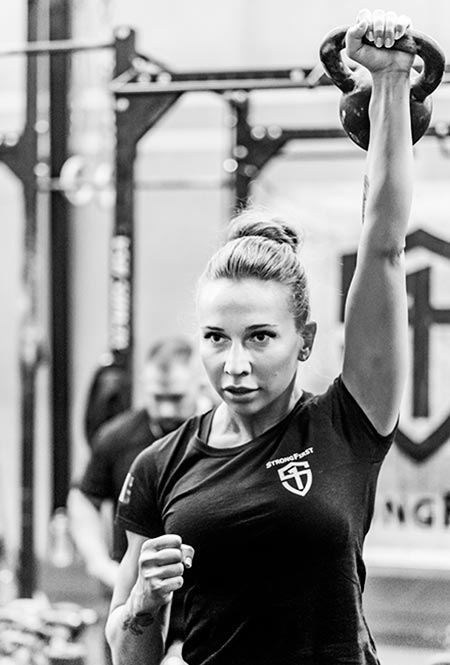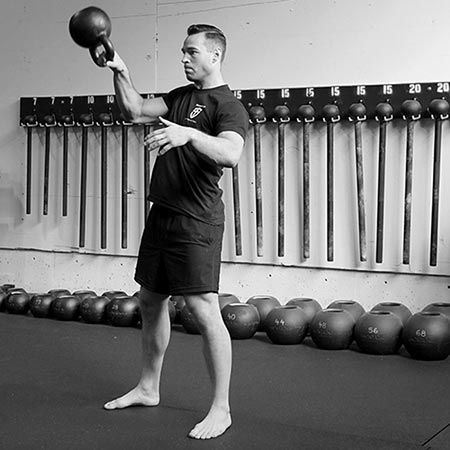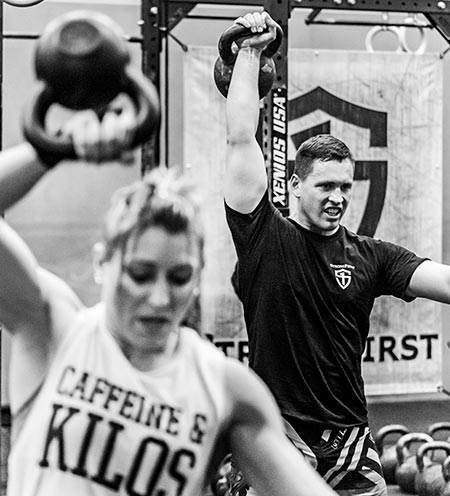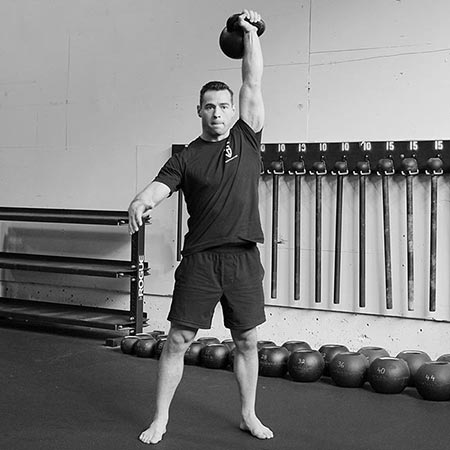Kettlebell snatches are one of my personal favorite lifts. They are athletic and explosive. They can be done with a variety of weights, tempos, rep schemes, and in my experience, give more “what the heck” (WTH) effects than anything else. There is a unique and gratifying sense of completion when you lock out each rep as opposed to the swing. And they also take care of nearly all of my strength and conditioning needs as far as carry over to martial arts. For these reasons (and probably more), snatches are something we train seriously in our group classes at Industrial Strength. Seriously enough that our group programs have produced impressive results for some lifters, including completing the five-minute, 100 reps snatch test with a 36kg (male) and 24kg (female).

This article will offer some guidance to intermediate level lifters who want to take their snatches to the next level. An intermediate lifter should be able to complete the five-minute snatch test to become an SFG instructor as well as “Simple” from Pavel’s Kettlebell Simple & Sinister. If you are still working towards the guidelines above, there are many great programs already in existence, and you would be wise to follow one of them before undertaking this material.
The Pyramid
Coaches often use a pyramid to illustrate the importance of building a good foundation. This includes a wide base that gradually allows you to reach a high peak. This is a great analogy for perfecting your kettlebell snatch technique as well. We will divide our pyramid into three levels: base, middle, and peak and each level will include two training protocols.

Base—Anti-Glycolytic Snatches and Swings
As referenced above, building the base of the pyramid is the most important aspect. If you have already met the snatch test and “Simple” standards, then you already have a nice foundation. What comes next is ensuring you not only retain it but continue to develop it.
- Snatches for sets of 5-10 reps performed explosively.
- Why? I believe the best foundation of kettlebell ballistics to be semi-short sets (five to ten reps) performed with high levels of power and sufficient rest to sustain that power as the overall reps accumulate. These sessions will not only build fitness, but do so with significant, high quality volume that will also condition your shoulders and wrists to stabilize your overhead lockout more effectively. They will also condition your grip (both your muscles and the skin on your hands) to hold up better for even more rigorous training. (If you want to take a deep dive into this style of training sometimes called Anti-Glycolytic Training or AGT, I encourage you to attend the Strong EnduranceTM seminar hosted by StrongFirst where you will learn about the physiology behind the programming, and also get a ton of training plans and templates you can put to immediate use.)
- How? A good rule that can be applied to almost any training goal is “let the volume do the work for you.” In this case you will be looking to condition your body to snatch your test-size kettlebell explosively for a lot of volume, eventually working up to around 200 reps per session on occasion. A few ideas to get started would be sets of five reps every 30 to 60 seconds or sets of ten reps every one to two minutes. Keep in mind that you are missing the point of this style of training if fatigue or callus problems start to slow your reps down. It is preferable to take longer rest periods or even skip a round or two in order to recover enough to perform all the reps with good power.
- Heavy two-handed swing with moderate rest breaks.
- Why? These sessions will expose the hips to some heavier weights without taxing the grip much at all. And because a set of swings takes less time than the same number of snatches, your hips will be firing at a higher RPM thereby getting you used to an increased cadence.
- How? For these a simple protocol such as ten reps performed at the top of each minute (TOTM) for ten sets works well. You can also halve the reps and double the sets, so five reps for twenty sets performed every 30 seconds. For even more variety you can alternate sets between two-handed swings and double swings (such as a 48kg and then a pair of 24s). Generally, about 100 reps per session is great, although don’t be shy about venturing above that. You could go for 150 or even 200 as long as the rest breaks are long enough. Do these early in your session so they are powerful, because just like the snatches above if you drop power then you are missing the point of this style of training. These can be a great thing to do before strength movements (squats, get-ups, presses, and so on).
Middle—Build Strength, Power, and Grip Endurance
These start to become a bit more specific towards the snatch test, but are still somewhat sustainable.
- Heavy, low rep snatches.
- Why? These are valuable to help build not only physical strength, but also confidence. Spend some time snatching a kettlebell 4-8kg above the size you plan to test with and you will have a mental edge when you get back to your standard weight. Additionally, they will help build up a strength reserve in your grip, upper back, and hips, and will teach you a lot about a stable overhead lockout.
- How? The keys to success here are similar to the AGT training above: keep every rep explosive, and give sufficient rest breaks that fatigue is not an issue and you feel fresh going into each set. I recommend a lower volume here. We have found that about 50 snatches per session is great. One great way to achieve your 50 reps is five reps per set for ten sets. You would do this by setting a timer to beep every 60 seconds, and every beep you do one set of snatches and then rest for the remainder of the round. Round one is five on the left, round two is five on the right. You could occasionally mix in sessions where the timer is set for two-minute intervals, and at each beep you would do both arms back to back with a swing switch in between. Each set would be five left and five right before resting. (Keep in mind that you need to use good judgement and modify this to your current ability. For example, when you first start you might only be able to manage three reps safely with a particular kettlebell, and that is fine. As you improve, you may eventually be able to go as high as ten reps with that same kettlebell.) I recommend sessions of 50-100 reps total, which is achieved by performing sets of 3-10 reps at a time. With that said, doing ten sets of five reps is time tested as a great place to start. Lastly, for maximum improvement, I also recommend you hold your lockout longer than normal here. If we are doing these to gain confidence with that weight over your head, then go ahead and spend some time there on each rep.
- Higher rep sets of snatches and one-arm swings.
- Why? Most people find that their grip is a limiting factor for them during their snatch test. High rep sets will both build grip strength and grip endurance. They will also help you become more aware of when your grip is starting to fatigue, letting you know it is time to switch hands.
- How? A good goal is to work up to being able to do 25 snatches or more on one hand with your snatch test kettlebell without stopping. You can either do these as a set on the left, then a rest, then a set on the right, or you can do it with a swing switch between hands (the latter is more difficult). You can also do these with heavy one-handed swings—sets of 20 with a weight approximately 50-percent heavier than your snatch test weight will do wonders for grip strength and confidence. For training guidelines, two to four sets per arm per session work well. When doing these, be sure to rest quite a while between sets (you will catch your wind within a minute or two after the set, but your grip, shoulders, and prime movers in your hips and legs will need longer to recover). As an example, set a timer to beep every five minutes. During round one do a set on your left arm for “as many as pretty” then rest actively for the remainder of the round. During round two match that number on your right arm. Keep the timer going and repeat this for two to four rounds per arm and be sure to vary the number of sets from week to week.
Peak
Peaking strategies are things to implement a few weeks before you plan to test, or every now and then if you are just training generally without a specific date in mind. These peaking protocols tend to be pretty rough (especially the snatch one below), and if you’re not careful they can take more out of you than they give back. I encourage you to do them but do so sparingly. Also, it will be extra important to be disciplined about any “stop signs” here. You should never let your technique slip, especially when putting the pedal to the metal in this training.

- Heavy two-handed swings done with high density and short duration.
- Why? Let’s be honest, the last two minutes of your snatch test are brutal in any number of ways, and if you do not get exposed to at least something that gives a similar feeling ahead of time then you are in for a rude awakening on test day. Heavy swings will overload your hips more than snatches and will also be easier on your hands and calluses, which is why they are preferred in this case.
- How? Using a kettlebell about 50-percent heavier than your snatch test size, try to average about fifteen to twenty reps per minute for five to seven minutes. Suggested breakdowns include five reps every twenty seconds; seven to ten reps every 30 seconds; or fifteen reps every minute. Do these as the last thing in your session because you probably will not want to do much else afterwards. Keep your reps explosive.
- Long sets of unbroken snatches.
- Why? These are fantastic for learning pacing and building confidence going into your snatch test. Similar to above, we know the last two minutes of your snatch test are going to be rough and require you to dig deep. If you go into it knowing you have “been there” for the first 70 or so, it will help you stay calm and keep something in the tank for those final minutes.
- How? Using your snatch test kettlebell, see if you can get up to 70 reps without setting the bell down, but switching hands as often as you like. If you can hit that number, you are probably set up well to get over 100 on snatch test day. A few tips here include making sure to own your lockout. Don’t waste energy lifting the bell up if it won’t count. Find a sustainable breathing pattern, and do your first hand switch at about ten reps under your max (if your max is 25 on the left, then switch at 15). As with above, you probably will not want to do much after these, so doing them either at the end of your session or as a stand-alone quick session is recommended.

Although I’ve described the pyramid in its entirety, I want to reinforce the importance of making sure you spend most of your time building your base. Once you get stronger at the base protocols start including some from the middle level. Ease into the middle level slowly, but once you get the hang of it you will probably find ways to include those in your training on a regular basis. The peaking sessions should be included, but not necessarily all the time (in particular the unbroken snatch session should be used sparingly). The combination of all the protocols in the recommended ratios will take your snatch test to the next level.









Great article. Thank you and hello from Vancouver, WA!
Thanks for the kind words Luis! Glad to see the StrongFirst community growing here in NW Oregon / SW Washington 🙂
Great stuff Tony! Very much appreciated.
Thank you! Glad you find it helpful
Great stuff, Tony! Do you typically perform 2 snatch sessions and 1 swing session per week with these protocols?
Hi Ryan, thanks for the kind words, I’m glad you find it helpful. Frequency can be dependent on many variables, but I most often find myself doing (and recommending) 2x per week of the ballistics and 2x of a strength / grind focus. 3x per week can absolutely be done though.
Thank you for the response. That is very helpful! Always cool to see what others are having success doing.
You are very welcome. Hope it is helpful!
Solid programming, Thank you.
Glad you find it helpful!
God help anyone entering the ring against you! WOW!
Haha thank you 🙂
Thank you Tony, this is exactly what I needed to improve my snatch game!
Excellent, I’m glad it is helpful for you!